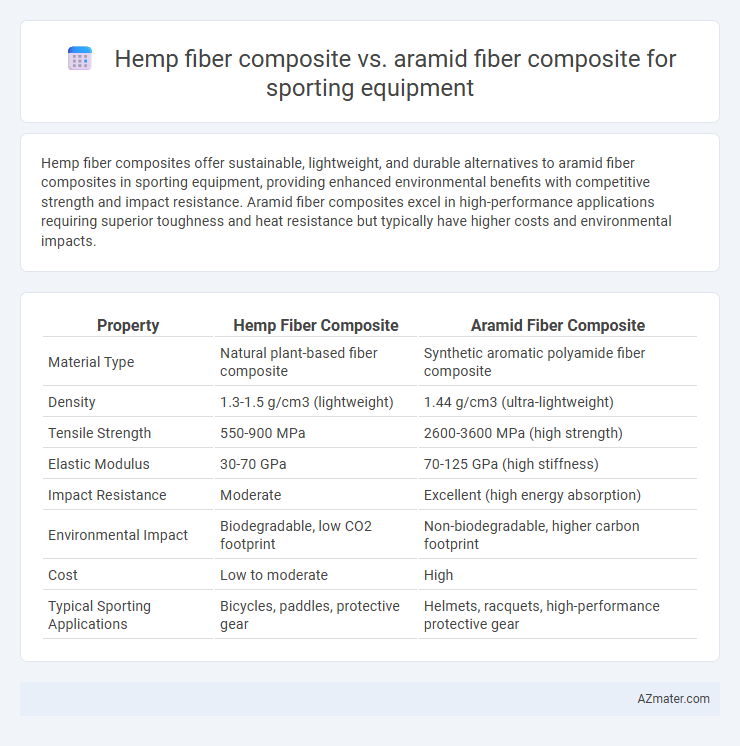Hemp fiber composites offer sustainable, lightweight, and durable alternatives to aramid fiber composites in sporting equipment, providing enhanced environmental benefits with competitive strength and impact resistance. Aramid fiber composites excel in high-performance applications requiring superior toughness and heat resistance but typically have higher costs and environmental impacts.
Table of Comparison
| Property | Hemp Fiber Composite | Aramid Fiber Composite |
|---|---|---|
| Material Type | Natural plant-based fiber composite | Synthetic aromatic polyamide fiber composite |
| Density | 1.3-1.5 g/cm3 (lightweight) | 1.44 g/cm3 (ultra-lightweight) |
| Tensile Strength | 550-900 MPa | 2600-3600 MPa (high strength) |
| Elastic Modulus | 30-70 GPa | 70-125 GPa (high stiffness) |
| Impact Resistance | Moderate | Excellent (high energy absorption) |
| Environmental Impact | Biodegradable, low CO2 footprint | Non-biodegradable, higher carbon footprint |
| Cost | Low to moderate | High |
| Typical Sporting Applications | Bicycles, paddles, protective gear | Helmets, racquets, high-performance protective gear |
Introduction: The Role of Fiber Composites in Sporting Equipment
Hemp fiber composites offer a sustainable alternative with high tensile strength and excellent vibration damping, enhancing the durability and comfort of sporting equipment. Aramid fiber composites, such as Kevlar, provide superior impact resistance and lightweight performance, making them ideal for high-performance gear like helmets and protective padding. Both materials contribute to advancing sports technology by improving strength-to-weight ratios and athlete protection.
Overview of Hemp Fiber Composites
Hemp fiber composites offer a sustainable alternative for sporting equipment due to their high strength-to-weight ratio, biodegradability, and cost-effectiveness compared to synthetic fibers. These composites exhibit excellent vibration damping and impact resistance, enhancing athletic performance and durability in gear such as helmets, bats, and protective pads. While aramid fiber composites provide superior tensile strength and heat resistance, hemp fibers contribute to eco-friendly manufacturing with reduced environmental impact and comparable mechanical properties for many sports applications.
Overview of Aramid Fiber Composites
Aramid fiber composites, known for their exceptional strength-to-weight ratio and high tensile strength, are widely used in sporting equipment such as helmets, racquets, and protective gear. These composites offer superior impact resistance, excellent fatigue performance, and thermal stability, making them ideal for applications requiring durability and safety under stress. Compared to hemp fiber composites, aramid fibers provide enhanced performance in high-impact and high-stress sports environments.
Mechanical Properties: Strength and Durability Comparison
Hemp fiber composites exhibit high tensile strength and excellent impact resistance, making them a sustainable alternative for sporting equipment needs. Aramid fiber composites, such as Kevlar, offer superior strength-to-weight ratios and exceptional durability under repetitive stress, ideal for high-performance applications. While hemp fibers provide advantageous vibration damping and biodegradability, aramid fibers outperform in tensile modulus and long-term fatigue resistance, influencing the choice based on specific mechanical performance requirements.
Impact Resistance and Flexibility Analysis
Hemp fiber composites offer notable impact resistance due to their natural fiber structure, making them effective in absorbing shocks in sporting equipment, while also providing superior flexibility compared to synthetic fibers. Aramid fiber composites, such as Kevlar, excel in high tensile strength and impact resistance, delivering exceptional durability under intense stress but with comparatively lower flexibility. The balance between impact resistance and flexibility in hemp composites supports better energy dissipation and bending properties, whereas aramid composites prioritize maximum strength, ideal for protective gear requiring rigid structural integrity.
Weight and Performance Considerations
Hemp fiber composites offer a lightweight alternative with excellent vibration damping, making them suitable for sporting equipment that prioritizes comfort and sustainability. Aramid fiber composites provide superior strength-to-weight ratios and impact resistance, enhancing performance in high-stress applications like protective gear and high-performance sporting goods. Weight considerations favor hemp composites for lower overall mass, while performance metrics such as tensile strength and durability typically advantage aramid composites in demanding sports environments.
Environmental Sustainability and Lifecycle Assessment
Hemp fiber composites exhibit superior environmental sustainability compared to aramid fiber composites due to their renewable, biodegradable nature and lower energy-intensive production processes. Lifecycle assessment reveals hemp composites generate significantly less carbon footprint and reduce end-of-life disposal challenges, supporting circular economy principles in sporting equipment manufacturing. While aramid fibers provide high strength, their petrochemical origin and recyclability limitations pose environmental concerns, making hemp fiber composites a greener alternative for sustainable sports gear.
Cost-Effectiveness for Manufacturers and Consumers
Hemp fiber composites offer significant cost advantages over aramid fiber composites due to lower raw material expenses and simpler processing techniques, making them highly attractive for sporting equipment manufacturers seeking affordability. These composites provide competitive mechanical properties with reduced environmental impact, leading to lower production costs and more accessible pricing for consumers. While aramid fibers deliver superior strength and durability, hemp composites balance performance and cost-effectiveness, enabling broader market adoption in mid-range sports gear.
Real-World Applications in Sports Equipment
Hemp fiber composites offer natural, eco-friendly alternatives to traditional materials in sporting goods, providing lightweight and durable solutions ideal for products like skateboards, bicycle frames, and protective gear. Aramid fiber composites, such as Kevlar, are extensively used in high-performance sports equipment requiring exceptional strength and impact resistance, including helmets, racing paddles, and body armor. The integration of hemp fibers enhances sustainability and vibration damping, while aramid fibers contribute superior tensile strength and abrasion resistance, making each composite suitable for specific performance demands in sports applications.
Future Trends: The Evolution of Fiber Composites in Sports
Hemp fiber composites are gaining traction in sporting equipment due to their sustainability, lightweight nature, and shock-absorbing properties, while aramid fiber composites remain dominant for their exceptional strength and impact resistance. Future trends indicate a hybrid approach, combining hemp's eco-friendly benefits with aramid's durability to enhance performance and reduce environmental impact. Innovations in bio-based resin systems and fiber treatments are expected to further improve composite performance, driving a new era of high-performance, sustainable sports gear.

Infographic: Hemp fiber composite vs Aramid fiber composite for Sporting equipment
 azmater.com
azmater.com